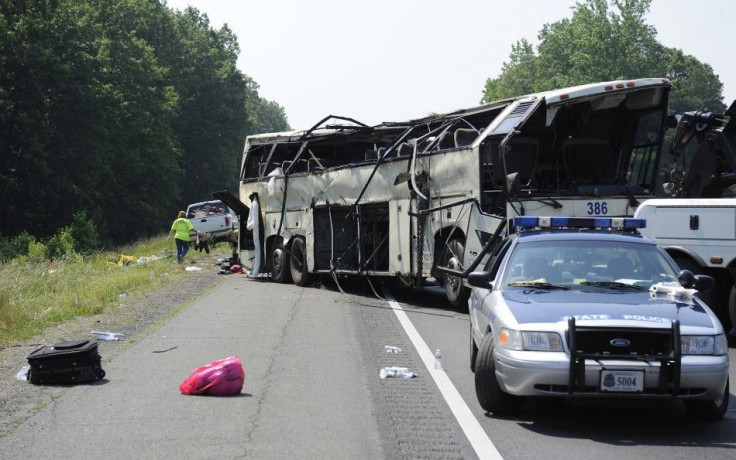Curbside ‘Chinatown’ Buses’ Death Rate 7 times Higher than Competition: Report

Frequent Chinatown bus travelers be warned, a new report finds that the death rate on these curbside buses is seven times higher than that of traditional terminal-based companies.
According to a National Transportation Safety Board report released Oct. 31, curbside bus operators like the so-called Chinatown buses had 1.4 fatal accidents per 100 vehicles, compared with .2 crashes for terminal-based operators like Greyhound.
The study, touted as the most detailed look at curbside lines to date, argues that regulation has not kept pace with the rapidly-growing industry.
Intercity bus travel has become the fastest-growing U.S. mode of commercial transportation. U.S. bus departures increased by nearly 25 percent in 2010 and the curbside operators now far outnumber terminal-based companies.
Yet, uncertainty over safety has also grown. In 2011 alone, 28 people have died in eight fatal crashes. Three of those occurred within an 11-week period. They all involved carriers operating out of, or carrying passengers between Chinatown neighborhoods in East Coast cities.
It's abundantly clear that the oversight of this industry has not kept pace with its growth and the consequences have been deadly, New York Sen. Charles Schumer said in a press conference on Monday.
The Chinatown buses have become extremely popular along the northeast corridor, connecting passengers from Washington, D.C. to New York and on up into Boston.
More than half of the companies have been in business for 10 years or less and 44 percent have 10 or fewer buses. The smaller and newer companies are the ones most likely to get in an accident, according to the report.
It's time to recognize that traditional transportation services have morphed into new business models that challenge existing regulatory constructs, NTSB Chairman Deborah Hersman said in a statement.
One of the main problems is that the Federal Motor Carrier Safety Administration that looks over the bus companies is overburdened. According to the report, there are 878 federal and state inspectors who oversee 765,000 bus companies. That's an average of slightly more than one inspector for 1,000 companies - and an in-depth review of a bus company can take up to two weeks or longer.
Business and safety practices within the growing curbside bus industry create challenges for enforcement authorities and consumers alike when it comes to separating the safe operators from the unsafe operators, Hersman said.
Many of the tickets for these buses are sold online at sites like Gotobus.com, and the safety administration has no authority to regulate the ticket brokers. This often leaves buyers unsure what bus company they are using and thus no way to evaluate the safety record.
Senator Schumer requested the report on curbside buses in March after a speeding bus ran off an elevated highway as it returned to New York's Chinatown after a night of gambling in Connecticut. That accident left 15 killed and 18 injured, and the bus' operator, World Wide Travel, was shut down for safety violations.
Another fatal accident in May involved a bus traveling from Greensboro, N.C. to New York's Chinatown. It veered off I-95 in Virginia, killing four passengers and injuring 50 others. According to court documents, the driver acknowledged falling asleep at the wheel.
It was later revealed that the bus' operator, Sky Express, had been cited 46 times for driver fatigue in a two year period.
What happened next is one of the biggest causes for concern in the industry.
Sky Express shut down, but within a matter of days resumed business under two new names. This practice is typical within the industry. Curbside companies make it very difficult for regulators to track them, the NTSB said. Several operate under multiple names and can spread safety violations among various entities. This hinders regulators' ability to spot patterns and target the appropriate companies.
Other issues highlighted in the report include drivers falsifying logbooks to evade limits on the number of hours they can drive, ghost buses painted white or black with little or no information about the company's name, and falsified names and addresses for selected companies.
Schumer hopes to increase the number of federal bus inspectors and require carriers to be graded from A to D according to their compliance with safety regulations.
[The report] cries out for action to make this industry safer, Schumer told Bloomberg. The consumer now buys a ticket in the dark.
Curbside buses sprang up in the 1990s as a cheap way for low-income Chinese workers to travel between Boston, New York, and Washington, D.C. Soon, budget travelers caught on and the industry began its steady growth, expanding throughout the Mid-Atlantic, Midwest and California. Rates begin at $1 and rarely go above $30 for a one-way journey.
Are you willing to pay a higher price for your safety? Let us know in the comments below?
© Copyright IBTimes 2024. All rights reserved.






















